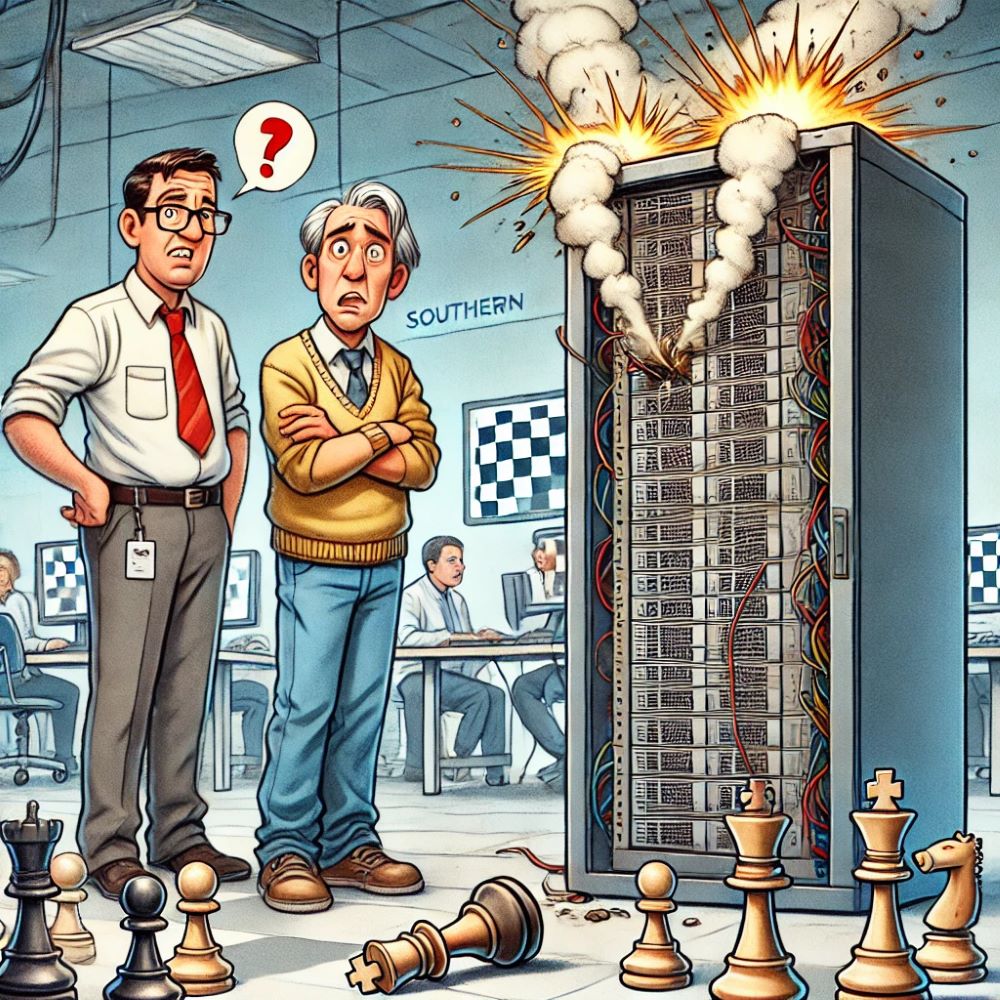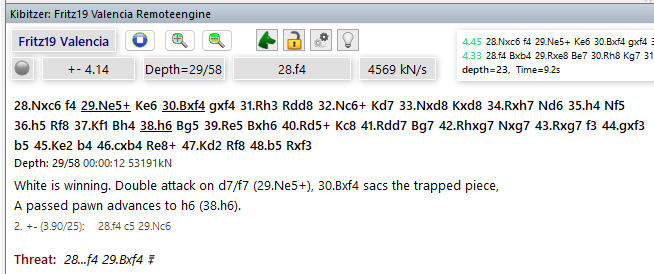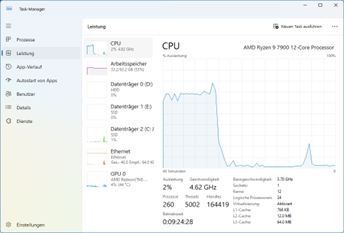Remote Engine in ChessBase 18: Power Everywhere
A remote engine does not run on your computer but in a data center. Here you’ll learn why the new remote engine is a smart addition to our proven cloud engines. How to run a remote engine without spending ducats? Why did our Helsinki machines give us quite a scare before the autumn discount day? And how did Fritz wreck a server rack? Check out the details and decide whether you can afford not to have the program. ChessBase 18 and Mega Database 2025 are available now on our shop. Upgrade from previous version is also available. Buy now if you haven't yet. Photo: ChessBase
In the early days of Fritz, I traveled with my colleague Mathias Feist to a southern German hardware manufacturer. They wanted to use the program as a marketing event by pitting it in simultaneous games against prominent players. We were given a nice server rack and installed our program on every unit within it. When we started all the engines, the fuse blew—definitely not an optimal promotion for reliability. Every chess player knows the lesson: an engine pushes a CPU to maximum load and requires a significant amount of power.

This is still relevant today. If you’re using an engine on your notebook while on the go, it drains your battery quickly. The CPU heats up, and your fan becomes noisy. This is where the new remote engine helps: the only resource it consumes is a few bytes of data with the main variations coming through your internet connection.

After installing ChessBase 18, the remote engine appears in the engine dialog. When you start the remote engine, a separate program opens:

On the first run, select your desired engine and hardware. If you have a ChessBase premium account, you can use the first machine for free. An engine with two CPUs is entirely sufficient for most analysis purposes. Select "Start Automatically" to launch the engine immediately upon activation. However, note that ducats-based engines will incur costs right at this point. Usually, users still prefer to start the engine right away.
Next, click the button "Save as Default" at the bottom to ensure the configuration is used for the next start. Finally, click "Start Engine." ChessBase waits in the background, and now the engine begins:

If you open your Task Manager to take a closer look under the hood, you might furrow your brow: Why does the remote engine generate over 60% CPU load? As shown in the above image, the Buddy feature is active, which always runs locally. You wouldn’t want to pay for Buddy comments using two servers. Simply deactivate it by clicking the green watchdog icon.

This shows the drop in CPU load in the Task Manager after turning off the Buddy engine.
Costs
The more powerful machines cost Ducats. For premium package buyers, this is convenient, as they receive a credit of 1,000 Ducats. Here’s a quick calculation showing why it’s not that expensive for users:
Take the largest server, the "Jumbo." Its CPUs have a total of 48 cores. For a machine of this scale, the CPU is a power guzzler. Add the main memory, perhaps consuming 1 watt/GB, shared cooling, power supply losses, and peripherals. Let’s assume 0.5 kW power consumption for such a server under full load. This would translate to electricity costs of about 17 cents or roughly 1.7 Ducats per hour if the machine were under your desk.
Anecdote: Servers and Power Costs
For a data center operator, electricity costs are the critical economic factor. One of our providers, therefore, invested in a data center in Helsinki, where cheap electricity comes from wind and hydropower. We prefer installing new machines in Finland because they are well-connected and cost-effective.
Shortly before our autumn sales campaign, the new Lichess cache server suddenly became extremely slow. Packet tracking revealed severe disruptions somewhere along the route to Finland. It was a moment of panic, as the launch of ChessBase 18 was imminent. Migrating seven billion games to another server is no small task. But Lutz Nebe, the cache server developer, got to work overnight. It quickly became clear that all Finnish servers were lagging. We thought: Maybe someone’s been tampering with a Baltic Sea cable.
A week later, news broke about the damage to the "C-Lion1" cable.
Hourly Rates
Booking a server for an entire hour is about twice as cost-effective as the more flexible minute-by-minute booking. However, the ducats price also applies if you stop using the server before the hour is up.
The "Engine" button shows the current billing. Under "Bills," you’ll find a history of your rentals. The free premium engine is listed here with 0 ducats/minute.
Changing Hardware Configurations
If you want to change engine software or hardware, adjust the relevant entries under "Default Engine." Then stop the current engine, and the new configuration will take effect on the next start.
Comparing Traditional Cloud Engines and Remote Engines
Cloud engines have long been available in ChessBase and are particularly popular among strong players. Many use the option of privately setting up powerful hardware for on-the-go use. However, traditional cloud engines are rented from a marketplace and depend on current availability. Some players are also uncomfortable with the idea that the provider could theoretically view their analysis.
The new remote engine runs on virtual servers in a data center. These servers are virtually always available and are freshly initialized when starting an engine. While we always keep several machines ready, starting a larger hardware setup may take up to two minutes. Once the server is running, the engine starts and stops without delay.
Finally, you can conveniently use the new remote engine as your default engine:
Default Engine
In ChessBase, you can set a default engine. This engine can be activated or deactivated without further prompts by clicking "Default Engine" or using the Alt-F2 shortcut. In the engine dialog, set this selection via right-click -> Properties.
If you promote the remote engine to the default engine and have "Start Automatically" checked in the default configuration, it will start with just Alt-F2.
Tip: You can also stop the engine by simply closing its own window. It will then be automatically removed in ChessBase. This is based on a new UCI command "Bye," which signals the interface to terminate the engine.
UCI Everywhere
The remote engine, like nearly all engines today, uses the UCI interface, which was developed in the late 1990s by Stefan Meyer-Kahlen and Mathias Feist. This makes it independent of ChessBase 18. It can run not only in Fritz but also in any other interface supporting UCI engines.
You can even download it for free here: https://remoteengine.chessbase.com/
ChessBase 18
ChessBase 18 - upgrade from ChessBase 17
ChessBase 18 and Fritz 19 Combo
ChessBase 18 + Mega Database 2025 Combo
ChessBase 18 Upgrade + Mega Database 2025 Upgrade
ChessBase 18 Mega Pack (CB18 + Mega 2025 + CB Account + 6 CBM Editions + 250 Ducats)
ChessBase 18 Premium Pack
Mega Database 2025
Mega Database 2025 - Upgrade from Mega Database 2024
Mega Database 2025 - Upgrade from Mega Database any year
Links
About the Author

Matthias Wüllenweber, CEO of ChessBase

















